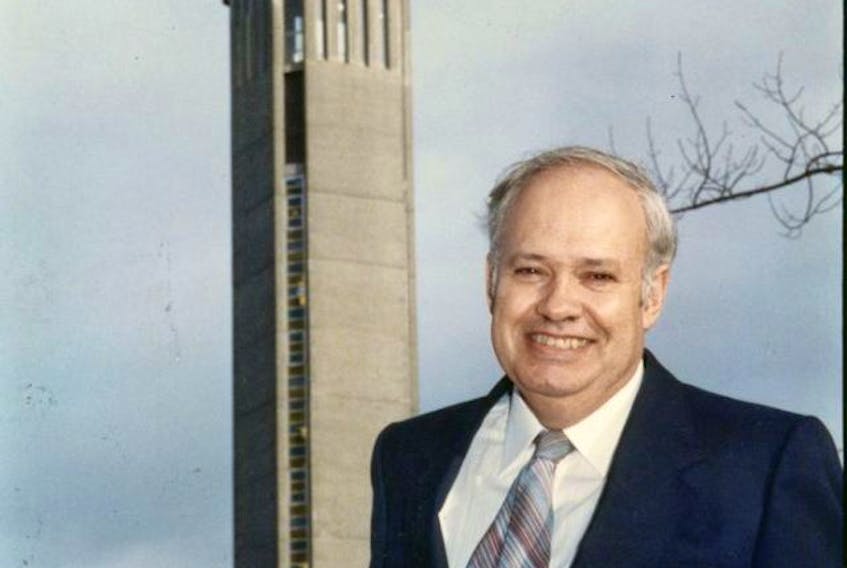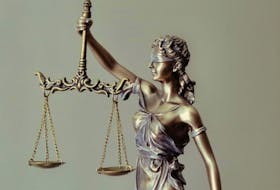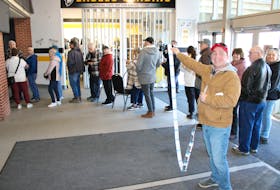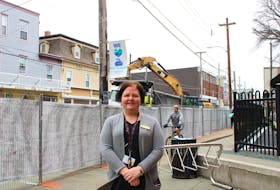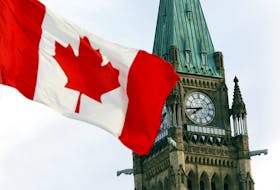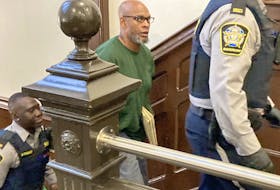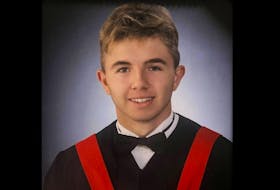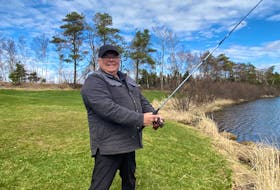VANCOUVER, B.C. — The entire world seemed to be watching the moon landing on TV on July 20, 1969. But Susan and Patricia Strangway were paying extra close attention, because their father was part of the broadcast.
“My dad was in Texas at mission control,” said Susan Strangway. “I remember my grandparents taking photographs of the TV. What else could you do in that day and age?”
At the time, David Strangway was a geophysicist at the University of Toronto. But he was also deeply involved with NASA, telling astronauts what rocks to pick up from the moon.
“To hear the astronauts talking from the moon to him, being broadcast to our living room, was like — wow!” said Susan Strangway.
In 1970, Strangway took a leave from the U of T to become the head of lunar and planetary operations at NASA. He stayed in Houston for four years before returning to the U of T, where he was named the interim president in 1984.

In 1985, he moved to Vancouver to become president of the University of British Columbia. He remained at UBC for a dozen years, and later founded Quest University in Squamish. He died in at 82.
On the 50 th anniversary of the moon landing, his daughters looked back at their father’s involvement with NASA.
“In 1969 when Apollo 11 (went up), the focus of that trip really was to get a man on the moon,” said Patricia, whose last name is now Forrest. “But they did bring about 50 pounds of rocks back, which were disseminated to a few different labs, one of which was my dad’s at U of T. He got some of the first moon rocks that were ever brought back.”
He flew with the moon rocks from Houston to Toronto.
“The moon rocks were just in his general luggage, mixed in with his clothes,” said Susan Strangway.
At customs the guard asked if he had anything to declare.
“He said ‘I’ve got a bunch of moon rocks,’ which they took as a joke, laughed and waved him through,” said Susan.
“That night the doorbell rang (at the Strangway house), in the middle of the night. It was a big open concept house and my parents were in the living room/dining room with the customs people.
“They had learned from the press that the moon rocks were in Canada. They were very jovial — my dad really hadn’t done anything wrong, he answered the questions they had asked. But they brought forms to sign, because how does customs deal with things that are not of this earth?”
They let him keep the moon rocks, and he brought them to show to Susan’s Grade 2 class at Millwood School in Toronto.
“We had just moved from Boston, so I was still talking with a Boston accent,” said Susan. “I think it definitely heightened my popularity, which needed some heightening!”
David Strangway took the family to Houston in 1970.

“After (Apollo 11) NASA realized that part of their focus wasn’t just putting man on the moon, it was actually analyzing what they could get off the moon, understanding what that meant for how everything was created,” said Patricia. “So they hired him as their chief geophysicist, starting in 1970. In 1969, at the time of the Apollo 11 he was one of their chief analysts.”
“There weren’t many lunar physicists at the time,” said Susan. “He became one of the first and leading lunar physicists in the world.”
He worked at NASA from Apollo 12 through Apollo 17, the last mission in the Apollo program, and the last to send a man to the moon.
“We knew all the astronauts,” said Susan. “At our local pool we used to swim with Neil Armstrong’s daughter. My parents socialized with the astronauts and NASA people.”
“My mom talks nostalgically about hobnobbing with the astronauts’ wives and being part of that whole scene,” said Patricia. “Their wives were like movie stars at the time. Especially when they were in space, the wives could hardly even leave the house without being flooded with press.”

Back in Toronto, David Strangway became head of the geophysics department at U of T, then the vice-president of academics and finally the interim president before moving to UBC.
Not bad for somebody from Simcoe, Ont., who grew up in Chisamba, Angola, where his parents were medical missionaries. He returned to Canada for university, earning his PhD at U of T.
His experience at NASA stayed with him the rest of his life — he used to keep a box of moon rocks in his office at UBC. (His daughters thought they were now at the HR McMillan Space Centre, but they aren’t — their whereabouts are unknown.)
The night he died, it was a supermoon, the closest the moon gets to earth.
“My husband said ‘you have to stop and look at the moon,’” said Patricia. “I looked up, and it was absolutely huge, I’ve never seen a moon like that. My husband and I looked at the moon and said ‘The moon is saying goodbye.’”
“The other night, it looked like a harvest moon,” said Susan. “You can’t help but look up and say ‘My father brought me a piece of that, to my class.’”
Copyright Postmedia Network Inc., 2019
READ MORE
- Fifteen fantastic facts: Lunar litterbugs, and other things you didn't know about Apollo 11 and the moon
- Canadian doctor's dream job was flight surgeon for Apollo 11
- Apollo 11's astronauts snapped photos for science. Then came MTV
- Apollo moon rocks shed new light on Earth's volcanoes
- COLBY COSH: Apollo 11's anniversary reminds us of a world now out of our grasp
- MARK TOWHEY: The space race — Sputnik to Apollo
- CINDY DAY: Looking up while we look back a half-century
- Apollo 11, 50 years later: NASA astronaut recalls being the voice of the first lunar landing
- Apollo astronauts celebrate 50 years since first moon landing
- Rocket blasts off in southern Alberta to commemorate Apollo 11 anniversary

